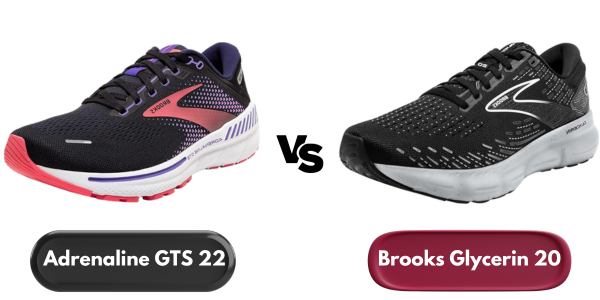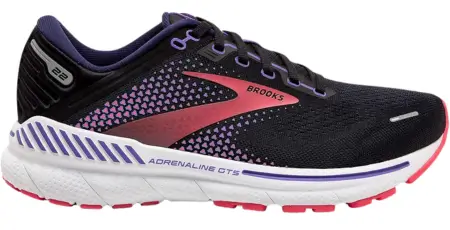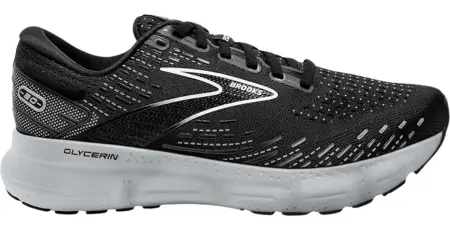Brooks Adrenaline GTS 22 Vs Brooks Glycerin 20 Running Shoes [2025]
Last Updated: January 01, 2025 | Author: Jake Thompson
I remember the first time I slipped on the Brooks Adrenaline; it was like my feet found their guardian angel, especially with my tendency to overpronate.
On the flip side, the Glycerin has been like a treat for my soles with its plush cushioning on long, easy runs. Deciding between these two can be tough.

The Adrenaline offers that essential stability I need, while the Glycerin caters to my love for soft comfort. It's not just about picking a shoe; it's about choosing an experience that will go-to-support my running goals.
Whether I'm gearing up for a marathon or a casual jog, understanding the main differences in cushioning, support, and overall feel between Adrenaline and Glycerin is crucial.
So, I'm here to share what I've found in my journey, hoping it'll guide you in finding your perfect fit.
Table of Contents:
- Key Takeaways (Brooks Glycerin vs Adrenaline)
- Table: Brooks Adrenaline GTS 22 Vs Brooks Glycerin 20 Running Shoes [2025] - Detailed Comparison
- Cushioning Comparison
- Stability and Support
- Fit and Comfort
- Upper Construction
- Midsole Technology
- Outsole Durability
- Design and Aesthetics
- Performance Insights
- Pricing and Value
- Frequently Asked Questions
Key Takeaways (Brooks Glycerin vs Adrenaline)
- - Glycerin offers a luxurious feel with its thicker heel to toe stack height and full-length DNA Loft v3 foam for plush cushioning and responsiveness.
- - Adrenaline provides a slightly firmer ride with its slightly lower heel stack height and utilizes BioMoGo DNA and DNA Loft technologies for a tailored blend of cushioning and support.
- - Adrenaline offers higher stability and support compared to Glycerin, thanks to its Brooks GuideRails technology and DNA Loft foam that provides support without compromising cushioning.
- - Glycerin prioritizes a cushioned ride over stability and support, making it a great choice for neutral runners looking for maximum cushioning.
Table: Brooks Adrenaline GTS 22 Vs Brooks Glycerin 20 Running Shoes [2025] - Detailed Comparison

|

|
|
|---|---|---|
| Feature | Brooks Adrenaline GTS 22 | Brooks Glycerin 20 |
| Cushioning | Slightly Firmer with DNA Loft Foam | Plush DNA Loft v3 Foam |
| Stability and Support | Higher Stability with GuideRails Tech | Neutral, Emphasizes Cushioning |
| Heel Stack Height | 30mm | Luxurious 34mm |
| Midsole Technology | BioMoGo DNA and DNA Loft Technologies | Full-length DNA Loft v3 |
| Upper Construction | Engineered Mesh with 3D Fit Print | Engineered Mesh with Gusseted Tongue |
| Outsole Durability | Blown Rubber with Segmented Crash Pads | Durable Blown Rubber with Omega Flex Grooves |
| Design and Aesthetics | Secure and Stylish with Mesh Design | Sleek Look with 3D Fit Print |
| Performance Insights | Supportive Structure for Overpronation | Plush Comfort Ideal for Daily Training |
| Price | ||
| Value Proposition | Balance of Cushioning and Support | Enhanced Comfort with DNA Loft v3 |
| Target Runner | Those Needing Stability | Lovers of Plush Cushioning |
Cushioning Comparison
When comparing the cushioning of the two models, I've noticed that the Glycerin features a thicker 34 mm heel stack height for a more luxurious feel, whereas the Adrenaline offers a slightly firmer ride with its 30 mm heel stack.
Diving deeper, the Glycerin's midsole is constructed with the full-length DNA Loft v3, a nitrogen-infused supercritical foam. This cutting-edge material delivers not only plush cushioning but also remarkable responsiveness that doesn't compromise energy return.
In contrast, the Adrenaline is engineered with a combination of BioMoGo DNA and DNA Loft technologies. While still cushioned, it provides a tailored blend that emphasizes support, suitable for controlling overpronation.
The nuanced differences in their midsole compositions are critical for runners prioritizing either cushion or stability.
Stability and Support
I've found that the Brooks Adrenaline offers a higher degree of stability and support compared to the Glycerin, catering specifically to runners who need extra help with overpronation. As a stability shoe, Adrenaline makes use of the innovative Brooks GuideRails technology, which is essential for keeping excessive foot movement in check. These GuideRails act like bumpers to ensure my feet stay in their natural motion path. The result is a supportive ride that's indispensable for my overpronation during long runs.
Additionally, the Adrenaline's DNA Loft foam contributes to its go-to support without compromising the overall cushioning. This careful balance of support and stability, paired with cushioning, reinforces my confidence in the Adrenaline as the superior choice for runners with specific stability needs.
Fit and Comfort
Transitioning from stability to comfort, I'll now delve into how the Brooks Adrenaline and Glycerin cater to the fit and feel aspect of running shoes.
The Glycerin's luxurious, plush cushioning is a standout, providing a glove-like fit that cradles the forefoot with each stride.
On the other side:
Brooks Adrenaline GTS
- - Engineered Mesh: Delivers secure, structured fit
- - Comfortable Fit: Balances stability with comfort
- - Heel-to-Toe Drop: Accommodates those needing support
Brooks Glycerin
- - DNA LOFT v3: Offers ultra-softness underfoot
- - Breathable Upper: Ensures a cool and comfortable run
- - Plush Feel: Emphasizes a luxurious comfort experience
Analyzing these features, I find that the Glycerin offers a more cushioned ride, while the Adrenaline provides a comfortable fit without compromising the necessary support for overpronation.
Upper Construction
In discussing the upper construction of the Brooks Adrenaline and Glycerin, I'll focus on the materials and design that contribute to their distinct fit and feel.
The Adrenaline also features an engineered mesh upper that ensures breathability and flexibility while providing a secure foot lockdown. This is complemented by 3D Fit Print overlays that add targeted structure without unnecessary bulk.
The Glycerin, however, has faced scrutiny for its mesh design, which some runners find less supportive. Its gusseted tongue further aids in a snug fit, enhancing the glove-like feel.
Both models prioritize a breathable environment for the foot, but it's the precise engineering and the strategic placement of overlays that mark the difference in their breathable upper construction.
Each nuanced design choice contributes to the shoe's overall performance and comfort on the run.
Midsole Technology
Building on the upper construction, let's delve into the midsole technology where the Brooks Adrenaline and Glycerin differ notably in cushioning and support.
As an experienced runner, I've come to appreciate the nuances in midsole foam that can significantly impact a run.
Brooks Adrenaline:
- - BioMoGo DNA: This offers a tailored balance of cushioning that adapts to your stride, weight, and speed.
- - Support for Overpronators: Aimed at stability, it's a go-to for those needing extra underfoot support.
- - Segmented Crash Pad: Ensures smooth transitions and adds to the stability.
In contrast, the Glycerin provides:
- - DNA Loft v3 Foam: A plush, responsive feel that retains durability.
- - Neutral Running Shoe: Best for runners with a neutral gait seeking maximum cushioning.
- - Thicker Sole: Delivers a softer ride with a high heel stack for luxurious underfoot comfort.
Outsole Durability
I've scrutinized the outsole durability of both the Brooks Adrenaline and Glycerin models, noting their respective capabilities for withstanding extensive wear. The Adrenaline's durable outsole incorporates blown rubber and segmented crash pads, enhancing its longevity. The Glycerin's outsole, with its soft-blown rubber and omega flex grooves, also promises durability while providing smooth transitions.
Here's a comparative table highlighting their outsole features:
| Feature | Brooks Adrenaline GTS 22 | Brooks Glycerin 20 |
|---|---|---|
| Material | Blown Rubber | Blown Rubber |
| Design | Segmented Crash Pads | Omega Flex Grooves |
| Durability | High | High |
| Traction | Excellent | Excellent |
Both shoes demonstrate a commitment to excellent traction and durability through their thoughtfully designed outsoles, which include HPR for added resilience.
Design and Aesthetics
Regarding design and aesthetics, I'll now delve into how the Brooks Adrenaline and Glycerin running shoes compare visually and stylistically.
Brooks Glycerin
- - The upper of the Glycerin showcases a sleek, streamlined look with its engineered mesh design.
- - It employs the 3D Fit Print technology, which not only enhances the structure but also contributes to the shoe's modern aesthetic.
- - The lacing system is integrated seamlessly, providing both form and function without excessive overlay.
Brooks Adrenaline
- - In contrast, the Adrenaline features an engineered mesh that prioritizes foot lockdown, resulting in a design that's both secure and stylish.
- - Its overlay patterns are strategically placed to offer support, without compromising on design and aesthetics.
- - The fit is slightly roomier, especially in the toe box, which is subtly reflected in its appearance.
Performance Insights
As a runner who's tested both models, I've noticed the Glycerin's upper design translates into a supremely comfortable ride, while the Adrenaline's structure offers reassuring stability during long runs.
The Glycerin, as a highly cushioned neutral shoe, enhances my running experience with impressive shock absorption and smooth transitions that make it a top pick for daily training. Its plush feel doesn't compromise responsiveness, allowing for a balanced stride.
Meanwhile, the Adrenaline leverages guiderails technology to correct overpronation, essential for maintaining my natural movement pattern without overcorrection. Though it's a tad less flexible than the Glycerin, Adrenaline's support system is invaluable for the structural integrity of my runs, especially during challenging courses that test my endurance and stability.
Pricing and Value
When deciding between the Brooks Glycerin 20 and the Adrenaline GTS 22, I'm mindful that their price difference reflects the varying technologies and benefits they offer to runners.
Here's a breakdown:
Brooks Adrenaline GTS 22:
- - Price: Check on Amazon
- - Value Proposition: Balance of cushioning and support
- - Target Runner: Best for those needing stability
Brooks Glycerin 20:
- - Price: Check on Amazon
- - Value Proposition: Enhanced comfort with DNA Loft v3 foam
- - Target Runner: Ideal for lovers of plush cushioning
The difference between the Brooks Glycerin and Adrenaline boils down to personal needs. If you're into the best Brooks running shoes for stability at a more budget-friendly price, the Adrenaline GTS is the one to choose. Conversely, if you're after the softest running shoe, the Glycerin 20 is worth the extra cost.
Frequently Asked Questions
1- What's the Difference Between Brooks Glycerin and Adrenaline?
I'm analyzing the differences between two running shoes, focusing on their cushioning and stability features to determine which best suits specific runner profiles, based on their unique preferences and biomechanical needs.
2- Which Brooks Are Most Comfortable?
I'd say comfort is subjective, but generally, shoes with more cushioning are comfier. It's vital to test them personally, as comfort also depends on fit, gait, and what you find most supportive.
3- What Is the Difference Between Brooks Glycerin and Ghost?
I've researched the Brooks Glycerin and Ghost extensively and found that Glycerin offers more cushioning, while Ghost strikes a balance between cushioning and responsiveness, catering to runners who prefer a lighter, more adaptable shoe.
4- Do Brooks Adrenaline Have Good Support?
I've found that Brooks Adrenaline shoes do indeed offer good support, especially for overpronators like me who need stability during runs. They've been integral to maintaining my proper foot alignment and preventing injuries.
Share this:







